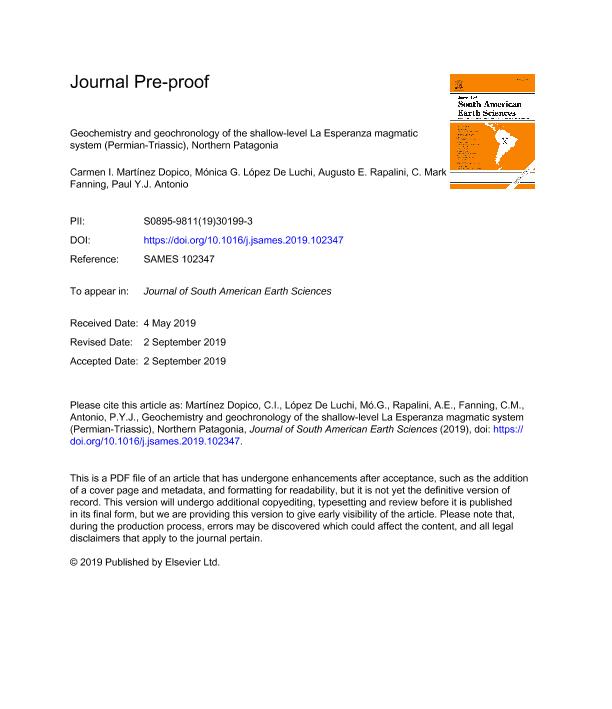Mostrar el registro sencillo del ítem
dc.contributor.author
Martínez Dopico, Carmen Irene

dc.contributor.author
Lopez, Monica Graciela

dc.contributor.author
Rapalini, Augusto Ernesto

dc.contributor.author
Fanning, Christopher Mark

dc.contributor.author
Antonio, Paul Yves Jean

dc.date.available
2021-11-25T05:53:13Z
dc.date.issued
2019-12
dc.identifier.citation
Martínez Dopico, Carmen Irene; Lopez, Monica Graciela; Rapalini, Augusto Ernesto; Fanning, Christopher Mark; Antonio, Paul Yves Jean; Geochemistry and geochronology of the shallow-level La Esperanza magmatic system (Permian-Triassic), Northern Patagonia; Pergamon-Elsevier Science Ltd; Journal of South American Earth Sciences; 96; 102347; 12-2019; 1-62
dc.identifier.issn
0895-9811
dc.identifier.uri
http://hdl.handle.net/11336/147376
dc.description.abstract
The La Esperanza plutonic-volcanic complex is the largest Late Paleozoic-Early Triassic composite magmatic system of northern Patagonia. This paper reports new SHRIMP U-Pb zircon ages and K-Ar muscovite dating as well as whole-rock geochemical data for selected units. In addition, we present some new and reprocessed whole-rock Sr isotopic compositions. On the basis of the new and published data, three compositionally and isotopically distinct high-K magnesian calc-alkaline series were distinguished. Two of these are characterized by high Ba-Sr: (i) biotite and muscovite bearing rhyolites and granites (265 ± 2 Ma; 260 ± 2 Ma) and (ii) metaluminous amphibole-biotite bearing granodiorites (273 ± 2 Ma), monzogranites (255 ± 2 Ma), dacites (253 ± 2 Ma), and slightly peraluminous granites (dated herein as 251 ± 2 Ma). There is also a low Ba-Sr series of high-silica metaluminous rocks (granites and acid dike swarms; 250 ± 2 Ma and ≈244 ± 2 Ma). Geochemistry coupled with geochronology revealed a pulsatory multi-sourced open magmatic system with mafic magma replenishment and reactivation of crystal mushes that occurred before upward migration to upper crustal levels. Mafic magmas alternated with crust-derived magmas incrementally assembled in subvolcanic levels over 30 Ma. Zircon crystallization and mica cooling ages in the granite units allowed detection of two magmatic lulls, between 270 and 265 Ma and between 260 and 255 Ma. Both episodes coincide with a period of exhumation in upper crustal levels. The new temporal and geochemical constraints allow correlation of the La Esperanza plutonic-volcanic complex with the Los Menucos Group (258-248 Ma), encompassing a volume of magmatism comparable to a moderately sized large igneous silicic province. These mid-to-late Permian to Middle Triassic rocks record the transition between subduction-related magmatism (>273 Ma) and post-orogenic extensional magmatism (<250 Ma) in the Gondwana margin. Even though this magmatism would be coeval with the proposed collision of the Patagonia terrane, no expected syn-collisional magmatism or associated deformation were found in upper crustal levels. However, the different nature and melting conditions of the inferred sources of the magmas that crystallized before 270 Ma, between 265 and 260 Ma, and from 255 to 245 Ma, suggest that the La Esperanza plutonic-volcanic complex was assembled during a 30 Ma period of major plate reorganization.
dc.format
application/pdf
dc.language.iso
eng
dc.publisher
Pergamon-Elsevier Science Ltd

dc.rights
info:eu-repo/semantics/openAccess
dc.rights.uri
https://creativecommons.org/licenses/by-nc-sa/2.5/ar/
dc.subject
GIMÉNEZ GRANITE
dc.subject
LA ESPERANZA
dc.subject
PATAGONIA
dc.subject
PERMIAN- TRIASSIC SLIP
dc.subject
U-PB ZIRCON GEOCHRONOLOGY
dc.subject.classification
Geoquímica y Geofísica

dc.subject.classification
Ciencias de la Tierra y relacionadas con el Medio Ambiente

dc.subject.classification
CIENCIAS NATURALES Y EXACTAS

dc.title
Geochemistry and geochronology of the shallow-level La Esperanza magmatic system (Permian-Triassic), Northern Patagonia
dc.type
info:eu-repo/semantics/article
dc.type
info:ar-repo/semantics/artículo
dc.type
info:eu-repo/semantics/publishedVersion
dc.date.updated
2020-11-20T18:07:35Z
dc.journal.volume
96
dc.journal.number
102347
dc.journal.pagination
1-62
dc.journal.pais
Estados Unidos

dc.journal.ciudad
Amsterdam
dc.description.fil
Fil: Martínez Dopico, Carmen Irene. Consejo Nacional de Investigaciones Científicas y Técnicas. Oficina de Coordinación Administrativa Ciudad Universitaria. Instituto de Geocronología y Geología Isotópica. Universidad de Buenos Aires. Facultad de Ciencias Exactas y Naturales. Instituto de Geocronología y Geología Isotópica; Argentina
dc.description.fil
Fil: Lopez, Monica Graciela. Consejo Nacional de Investigaciones Científicas y Técnicas. Oficina de Coordinación Administrativa Ciudad Universitaria. Instituto de Geocronología y Geología Isotópica. Universidad de Buenos Aires. Facultad de Ciencias Exactas y Naturales. Instituto de Geocronología y Geología Isotópica; Argentina
dc.description.fil
Fil: Rapalini, Augusto Ernesto. Consejo Nacional de Investigaciones Científicas y Técnicas. Oficina de Coordinación Administrativa Ciudad Universitaria. Instituto de Geociencias Básicas, Aplicadas y Ambientales de Buenos Aires. Universidad de Buenos Aires. Facultad de Ciencias Exactas y Naturales. Instituto de Geociencias Básicas, Aplicadas y Ambientales de Buenos Aires; Argentina
dc.description.fil
Fil: Fanning, Christopher Mark. The Australian National University; Australia
dc.description.fil
Fil: Antonio, Paul Yves Jean. Universidade de Sao Paulo; Brasil
dc.journal.title
Journal of South American Earth Sciences

dc.relation.alternativeid
info:eu-repo/semantics/altIdentifier/url/https://linkinghub.elsevier.com/retrieve/pii/S0895981119301993
dc.relation.alternativeid
info:eu-repo/semantics/altIdentifier/doi/http://dx.doi.org/10.1016/j.jsames.2019.102347
Archivos asociados
